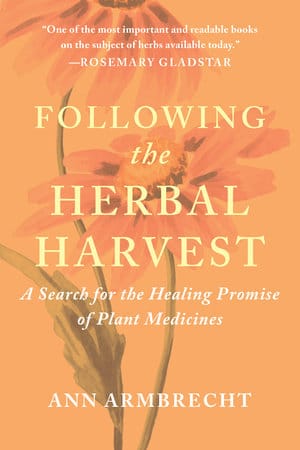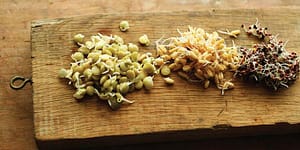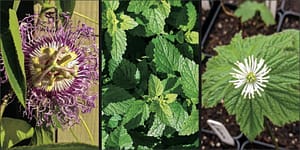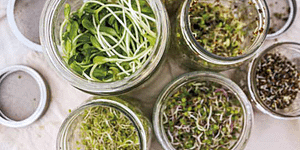The BIG Difference Between Small Farms and Big Business
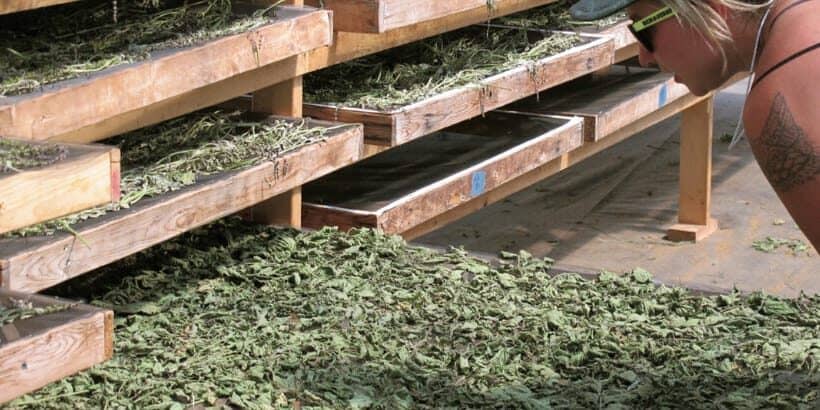
In the herbal medicine industry, due to a lack of quality checkers, it’s easy for any business to be certified “organic”. There is a big difference between small farms and big business, though, as author Ann Armbrecht discovers.
The following is an excerpt from Following the Herbal Harvest by Ann Armbrecht. It has been adapted for the web.
(Removing organic tulsi from drying racks at Zack Woods Herb Farm for garbling (garbling may be mechanized but can also be done by hand). Photo curtesy of Ann Armbrecht.)
Small Farms Vs. Big Businesses
At the last minute, Jeff Carpenter of Zack Woods Herb Farm had invited me to join the farm crew to harvest milky oats. The farm is an hour drive from my home and I headed out quickly, afraid they might finish before I arrived. I needn’t have worried. Even if they had finished, there is always work to be done on an herb farm.
Milky oats refers to oat seeds that are harvested when premature and a milky white liquid is present in the seed. The oat plants had fallen over after a heavy rain earlier in the week. The crew—Kate Clearlight, Brian Hoogervorst, and an intern—were sitting on the ground, harvesting the oats one clump at a time. Jeff handed me a basket. He showed me how to wrap my fingers with duct tape to prevent the sharp stalk from cutting my skin as I worked.
Kate showed me how to hold a clump with my left hand and slide my right up the stalk to pull the milky tops off the plants into the basket. The motion made a scraping sound like a paper cutter. The oats were striated with a reddish rust from a fungus, which, Kate told me, meant Jeff wouldn’t be able to charge as much for them.

Organic calendula fields at Zack Woods Herb Farm, Vermont. Photo courtesy of Jeff and Melanie Carpenter.
We each sat in our spot, harvesting the oats within reach. It was slow work and the sun was hot.
It took a long time to fill a basket. And there were a lot of oats. We talked some but mostly we just pulled off the oats in silence, each lost in our own thoughts.
When I’d harvested calendula at the farm earlier that summer—a task that had also seemed slow at the time but now, in comparison, seemed quite fast—Jeff had helped. But today he was busy taking care of duties around the farm.
At one point he stopped by and asked Kate, who was also the office and business manager for Zack Woods, whether she’d entered the amounts from the most recent harvest of nettles in the harvest log.
She hadn’t. “Good,” he answered. “That makes me feel better.” And then he headed off.
Kate mentioned that they had just found out that the skullcap had developed a fungal disease and wouldn’t be sellable, which meant they would lose a $4,000 wholesale contract.
Kate commented on how slowly the harvesting was going. Brian, who is the first employee Jeff hired after starting the farm, agreed. “At a certain point,” he said, “it is no longer cost-effective.”
After a while, Jeff checked in again and told us to head down to a lower field to harvest some more oats. We walked behind the Carpenters’ single-story ranch house to a gently sloping field bordered by woods where lemon balm, chamomile, and garlic grew in narrow rows. We began harvesting again.
After a few minutes Kate said she had learned that milky oats are ready to harvest when nine out of ten in each clump are milky. To tell if an oat is at the milky stage, you press it between your thumb and index finger. If a white latex substance squirts out, they are milky. She had counted only five out of ten in one handful, and, in another, only two or three. Brian said he would take some of the oats to Jeff and ask for his opinion.
“They’ll weigh more anyway if we wait,” Kate pointed out. Brian, who doesn’t use any medicinal herbs himself, commented, “Plus they’re more medicinal then. It isn’t all about the profit, you know.”
“Oh yeah, the medicine,” Kate (who is an herbalist) replied, laughing. Brian headed up the hill to find Jeff.
Small Farms: Questions of Scale
Zack Woods is a family-run small farm with six employees on ten acres at the end of a dirt road in northern Vermont. We had been working in a small patch of oats next to Mel and Jeff ’s house. Neat rows of plants in many shades of green, some with a blush of purple, bright orange, or dark pink, spread out around the house.
Straw mulch covered the soil, breaking the bands of green. From afar, the rows looked like strips of colors in a painting, small-scale and to my mind, right-sized, unlike the sameness of a sea of corn growing in fields in the Midwest.
Mel is Rosemary Gladstar’s stepdaughter, and she and Jeff previously ran Sage Mountain Herbs, a small herbal products company that made tinctures and salves. Like others who started herbal product businesses, they found it hard to source high-quality herbs. Jeff was working part-time in a nursery at the time. He liked working with plants and so they decided to start growing their own medicinal plants.
For the first few years after founding their herb farm, they continued working off-farm jobs—Jeff in a restaurant and Mel as a teacher and then principal of Stowe Middle School. They both now work full-time on the farm. Their goal is to provide the highest-quality certified organic herbal medicine they can.

Garbling or separating the leaves and stalks of organic tulsi at Zack Woods Herb Farm, Vermont. Photo curtesy of Ann Armbrecht.
Mel and Jeff believe passionately in the importance of small, family-run certified organic herbs farms, and their book, The Organic Medicinal Herb Farmer, describes how to cultivate medicinal herbs for the market.
Writing the book was a remarkably generous act, an herb grower once told me, considering that in doing so, Mel and Jeff were essentially educating their competitors.
Their niche works because there is a strong network of herbalists interested in buying certified organic and domestically grown herbs, especially those grown by small farmers who are also herbalists.
Mel and Jeff have succeeded by emphasizing their close involvement with the farm, their understanding of the life cycle of the plants they grow, their knowledge as herbalists about how the plants will be used, and their commitment to caring for the spirit of the plants.
Mel and Jeff ’s vision of healing is much broader than simply growing nettles and oats and yarrow. They are committed to the whole system of medicinal herb production. As Mel explained, “In order for the system to be sustainable, to be strong, to be well, for wellness for all, we need to make sure the system works on each level.
It needs to work from the ground level with the microbes in the soil, to the seeds, to the plants growing on the farm, to the ecosystem of the farm. How are the laborers being paid? How is their lifestyle when they leave the farm? How are they being treated on the farm? How are the plants being handled? When are the plants being harvested and are they respected?
“I am concerned about the herbal industry right now,” she continued, “because it seems it’s gone from the medicine of the people to big business. That scares me.
Not that I don’t want the medicine to reach more people, absolutely it should. But when it is done at the expense of the farmer, the plants, the workers, the planet—just so that some big business can make more money and sell more herbs—I have a real problem with that.” Yet it is difficult to see how to farm in accordance with these values and still provide the quantities needed to satisfy demand.
A month or so after harvesting those milky oats, I stood at the edge of an immense field of calendula, one of many fields of medicinal plants on a 160-hectare farm south of Frankfurt, Germany.

Conventionally grown calendula on a farm south of Frankfurt, Germany. Photo courtesy of Willow Fortunoff.
Rather than narrow bands of varying shades of green like those at Zack Woods, solid orange stretched almost to the horizon. The calendula was planted densely for ease of mechanized harvesting.
Though the same species as the calendula I had harvested the previous summer at Zack Woods, it seemed like an entirely different plant. The blossoms were smaller. Their orange coloration was less vibrant.
Each stalk bore several flowers in different stages—one or two in full bloom, a bud or two just opening, and several already gone to seed, the petals drying out and fading.
This crop of calendula would be harvested with a combine, which would mix together buds and flowers in different stages of flowering. At Zack Woods, by contrast, Mel, Jeff, and their field staff harvest daily by hand, selecting the full blossoms, to ensure the flowers are harvested at their peak.
The calendula from this German field would be sold as certified organic, just as Zack Woods calendula is.
Beyond that, the two farms seem to have very little in common, and I found myself wondering about how the extreme differences in their scale and methods impact the quality of the plants, in ways that can, and cannot, be measured. Mel and Jeff believe that the intention with which they farm, their attention to what they refer to as the spirit of the plant and to prayer, also impacts the energetics of the plants and their medicine.
What did energetics mean when growing herbs on this scale? Even without considering that question, there must also be differences related to soil health, water use, and fairness of labor practices. Wouldn’t these impact the quality of the medicine made from the plants grown on these two very different farms?
Recommended Reads
Want to Become an Herbalist? Drawbacks of the Herbal Renaissance
Recent Articles
Easy rainbow coleslaw! Transform your salad game with this colorful recipe. It is surprisingly packed with flavor and is a great addition to your repertoire.
Read MoreLearning how to ask questions that will elicit relevant information is as much an art form as creating an herbal formula. Follow this broad list as a starting point.
Read MoreWant to start your own medicinal herb garden? Passionflower, lemon balm, and goldenseal are great places to begin! These herbs are jam-packed with medicinal properties and easy to grow in a majority of climates.
Read MoreSprouts are easy to cultivate, mature quickly and pack a nutritional punch! You can make nutrient-rich sprouts from all kinds of edible seeds in your kitchen.
Read More
